Over the course of this ‘Lifting the Lid’ series I have covered all of the major aspects of lure fishing, but in best tradition I have saved the best until last! You see jig fishing not only piqued my interest, but completely revitalised my love of catching fish on lures full stop.
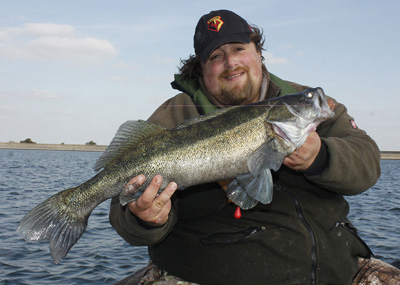 So why then did this method invoke a response that other methods had previously failed to do? Probably the simplest answer to this is that it worked very quickly and I caught fish on it right from the start. There is no better confidence booster in any new method than catching on it straight away and it’s remarkable how often it has happened for others too. I can well remember giving a spare rod to a friend of mine, a confirmed anti lure angle, and within the space of a few drop downs he had several small perch, including one of nearly two pounds, in the boat and he now is a regular jig angler!
So why then did this method invoke a response that other methods had previously failed to do? Probably the simplest answer to this is that it worked very quickly and I caught fish on it right from the start. There is no better confidence booster in any new method than catching on it straight away and it’s remarkable how often it has happened for others too. I can well remember giving a spare rod to a friend of mine, a confirmed anti lure angle, and within the space of a few drop downs he had several small perch, including one of nearly two pounds, in the boat and he now is a regular jig angler!
So what exactly is a jig? Well, let’s start by saying that jigs are nothing new, they have been about in many forms for many years and have been very popular on the continent and in the USA for decades. Only in recent times though have they taken off this side of the channel or pond, mainly down to the pioneering of anglers such as Matt Hayes, Mick Brown and Dave Pugh and, also I believe, thanks to the spread of zander.
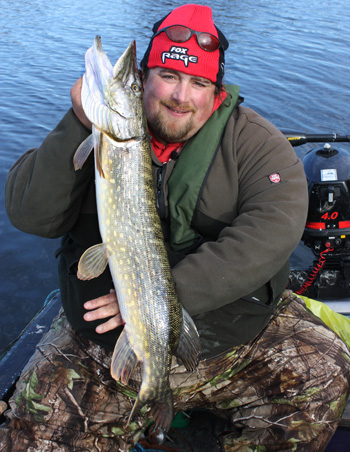 Now the latter part of that statement may seem quite strange but the truth of the matter is that if you want to catch pike, and only pike, then there are better methods open to you than jigging but if you want to catch perch and zander, and in numbers, there’s no better method.
Now the latter part of that statement may seem quite strange but the truth of the matter is that if you want to catch pike, and only pike, then there are better methods open to you than jigging but if you want to catch perch and zander, and in numbers, there’s no better method.
A jig basically consists of two parts: a hook with lead added to the eye that allows it to sink, and a body that can be made from a number of materials most commonly these days soft rubber. The body part is threaded onto the hook through its body and then you are ready to go.
Jigs come in various shapes, sizes and colours too but are generally less than six inches in length as the species they are aimed at catching are unlikely to take anything much bigger. That is where I will concentrate my efforts in this article, as that’s where we are looking at fishing.
To my mind jigs come in three main body shapes: shads – which are designed to look something like a fish, grubs – which really don’t look like anything in particular and worms – which look like, well worms! In principle all of them work in the same manner in that when they move through the water the action of the water causes the soft tail part of the lure to beat (as in the case of the shads) or to wriggle or squirm as in the case of worms or grubs.
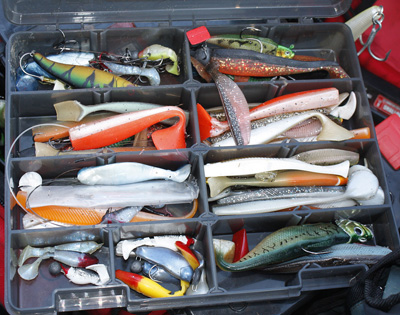 There are also two distinct fishing methods to using jigs: vertical jigging and cast fishing.
There are also two distinct fishing methods to using jigs: vertical jigging and cast fishing.
Casting jigs can obviously be done from both boat and bank, but vertical jigging is almost exclusively undertaken from a boat and is certainly at its best when fished from a slowly drifting boat.
The tackle required for both types varies just slightly. For bank fishing a slightly longer rod, between seven and eight feet, is handy to get over the near bank vegetation and a bank rod requires a slightly longer butt section so that you can cast with two hands should you wish to.
A vertical jigging rod has a very short butt as it is designed to be tucked along the length of your forearm when in use as this reduces the strain on your wrist and forearm. For similar reasons the reel that you match to your rod should be kept as small and light as possible and it is vitally important that it has a smooth clutch system. I use reels in the 2000 – 3000 Shimano size as you only need to hold 100 yards of braid, which these sizes do with ease.
For jig fishing from the bank in snaggy situations I may go as strong as 20lb breaking strain but from the boat I nearly always use 8lb breaking strain. There is a distinct reason for this that I will cover when I go into more detail on vertical jigging later, but it’s very important to remember that although this is much lighter gear than is normally used in predator fishing it is balanced and if clutches are set correctly then there is no reason that even very big fish can be landed.
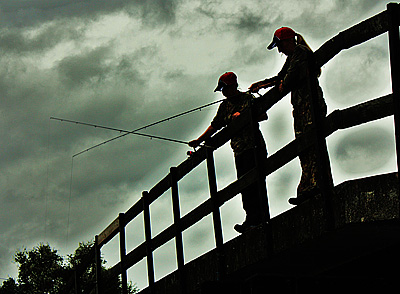 Bank jigging
Bank jigging
I guess that for most anglers this will be where they do the majority of their jig fishing and it is a very successful way of fishing too. I won’t hide from the fact that I much prefer to jig from a boat as you can get right into spots that you can only fleetingly fish from the bank, but there are times, and budgets, that rule out the use of a boat and so we have to fish in a different manner.
Personally I find that jig fishing from the bank requires even more concentration than from a boat. With a boat you can pretty much fish the depth that you want just by lowering the jig down to that depth and, once there, you are in direct contact with the lure pretty much all of the time. With bank fishing because you have to retrieve and impart action at the same time it is far easier to lose direct contact with the jig; the last thing that you want to happen and of course sod’s law says that this will be the moment that the predators decide to strike! Partly for this reason a day’s jig fishing can be mentally tiring as you need to feel the jig through the water column all the time and it is here where not having the right gear, or not using it incorrectly, makes life all the more difficult as you will lack the ‘feel’ of the jig as it descends, especially as we get towards the lighter end of the jig range, in the five gram and below range.
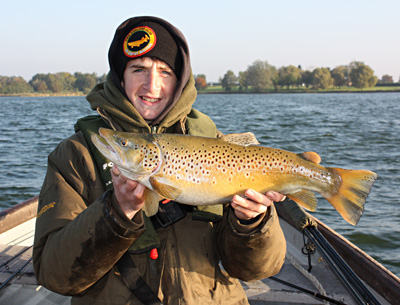 So to working the jigs correctly and this can be done in a manner of ways with the most basic being just casting out and retrieving on a straight retrieve. However, I have never found this a particularly productive way of fishing, particularly if you’re targeting perch and zander which are well known for staying deep in the water column. To get the perch and zeds interested in taking the lure we need to put it into their eye line or ‘strike zone’, for as long as possible and to do this properly you need to retrieve the lure as close to the bottom as possible for as long as possible.
So to working the jigs correctly and this can be done in a manner of ways with the most basic being just casting out and retrieving on a straight retrieve. However, I have never found this a particularly productive way of fishing, particularly if you’re targeting perch and zander which are well known for staying deep in the water column. To get the perch and zeds interested in taking the lure we need to put it into their eye line or ‘strike zone’, for as long as possible and to do this properly you need to retrieve the lure as close to the bottom as possible for as long as possible.
The type of retrieve I use to achieve this is a ‘long hop’ type: Upon casting I feel the jig all the way to the bottom until I feel the tell-tale ‘donk’ of the jig head touching down, whereupon I raise the rod a couple of feet (the rod descending towards the horizontal as the jig drops) to the vertical and turn the handle all the time to keeping in constant contact with the jig. When the jig touches down again I repeat the action until the jig reaches the bank.
Using this method you need to match the jig weight to the jig body in such a way as to make the descent of the lure as slow as possible – and remember on rivers you will need to factor in aspects such as current speed. The reason for this is virtually all takes come on the descent as this is when the jig is right in the fishes view and as it will be sizing it up for attack giving it as much time as possible in the zone cannot hurt.
In reality though this is quite a vigorous retrieve and come the really cold weather it just may be a bit too active for more sluggish fish. In winter I change the retrieve for a slower hop along the bottom so the jig doesn’t rise much above 18 inches off the deck. Again the hang time of the lure wants to be as slow as possible, only this time instead of large upward sweeps I tend to just give the lure a flick of the wrist, whilst all the time slowly retrieving the handle of the reel. This retrieve skips the jig along the bottom, right where a dormant fish may be laying.
Of course retrieves are forever there to be experimented with and it’s fair to say that for most of the time the retrieve will be a combination of all of those mentioned. It is, as with all lure fishing, a case of experimenting and seeing what works best on any given day.
Vertical jigging
Vertical jig fishing is, quite possibly, the most popular method of lure fishing worldwide and all over the globe anglers use verticals to catch bass, walleye, zander, pickerel, perch, pike and muskies, along with some kinds of trout (I had my PB catfish on one too – Ed) What then makes it so popular?
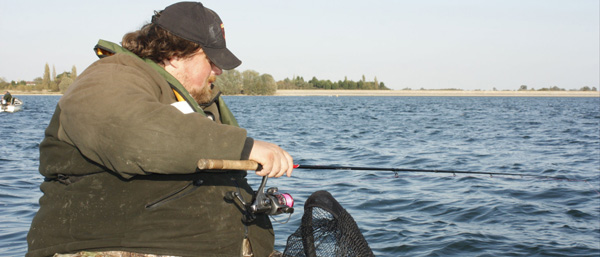
Quite simply it is because it is devastatingly effective! Not only can you cover a lot of water in a drifting boat, but you can quickly re-cover an area where you get takes from. On top of this jigs can be used to fish at the exact depth that fish are showing on a fish finder far easier than with any other type of lure, because they are working in predominantly the vertical, rather than horizontal plane.
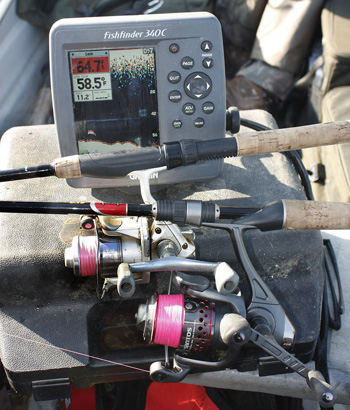 If anything else was needed to stack the odds in the angler’s favour because the jig is fished vertically, directly below the boat, exactly the right amount of action can be put into the jig and this is especially important on those days when the fish really don’t want the jig moving very much at all, a situation you just cannot replicate from the bank. To be honest though those days are thankfully rare and on most occasions some action in the jig is what is needed.
If anything else was needed to stack the odds in the angler’s favour because the jig is fished vertically, directly below the boat, exactly the right amount of action can be put into the jig and this is especially important on those days when the fish really don’t want the jig moving very much at all, a situation you just cannot replicate from the bank. To be honest though those days are thankfully rare and on most occasions some action in the jig is what is needed.
From a boat this is basically just an easy up and down motion, varying the speed of the upward motion from a slow draw to a quick flick. All the time this is going on the boat should be slowly drifting – with either whatever breeze is prevalent, by river current or by the use of an electric trolling motor. There will be occasions, of course, when there will be a bit too much wind and then a drogue or even two drogues should be used to slow down the drift of the boat. On these occasions you have to compromise slightly on the weight of the lure to make sure that it keeps vertically below the boat and doesn’t end up at 45 degrees being dragged and this is where the very light braid I mentioned earlier comes into its own.
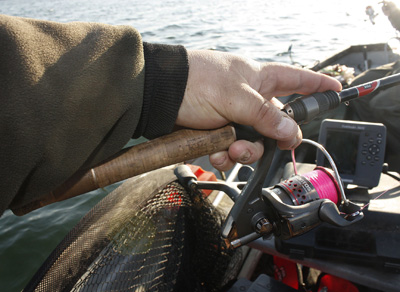 Because it has such a low diameter light braid offers less resistance to the water and slows the dragging effect up and if balanced with the right amount of weight on the jig head it will eradicate it completely, you just need to make sure that you have everything set on the reels correctly before starting fishing.
Because it has such a low diameter light braid offers less resistance to the water and slows the dragging effect up and if balanced with the right amount of weight on the jig head it will eradicate it completely, you just need to make sure that you have everything set on the reels correctly before starting fishing.
Personally I tend to favour reels with a ‘fighting drag’ mechanism at the back, like the Shimano Stradic range. I have the ‘fighting drag’ set from just giving at its tightest, to giving easily at its lowest and as soon as I hit into a fish I go into the lowest setting and work my way up, depending upon the size and power of the fish. In reality though everything that you hook on a jig rod is great fun and that’s half the reason why I love the method so much.
For the hours you have a jigging rod in your hand, the dyed-in-the-wool specimen angler departs and the ‘little boy’ in you comes back and I doubt that you can say much more in favour of a method than that, give it a go!











